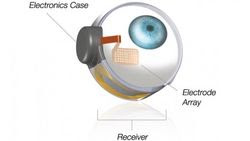Give sight to blind people is the specialty of Second Sight group that has already proven their effectiveness retinal prosthesis Argus II. Today the group announced that it successfully implemented in Braille technology. The Argus II prosthesis currently allows patients carrying to see partially objects, color and movement in the environment. Usually the artificial retina is coupled to a pair of spectacles provided with a camera to be a substitute for the defective retina to capture images.
The prosthesis is implanted in the eye of the patient, providing a network of deployed electrodes 60 on the retina. The camera has the wearer's eye then captures the images of the environment and converts the video signal into electrical pulses. These pulses are transmitted wirelessly to the electrodes that respond by stimulating the nerve cells of the retina and thus allow the patient to receive a visual representation.
Today researchers Second Sight have announced managed to delete the video interface of their equation and allowed the blind to read of Braille digital. In their experiment, only 6 electrodes were activated without using a camera. By choosing different activation motifs, the researchers were able to reproduce Braille, each electrode corresponding to the equivalent of bumps up the letter.
The images were projected and for half a second, whether single letters or words of four letters. In 89% of cases, patients have reported recognize letters and words in 80% of situations. Argus II already allows some patients to distinguish characters in books, but in a very small proportion. A system that would not be limited to those of a camera could then equipped the blind to read faster and more comfortably. Second Sight announces that a character recognition software might soon be offered to users of the prosthesis, without the need to change anything on the equipment already in place.
The prosthesis is implanted in the eye of the patient, providing a network of deployed electrodes 60 on the retina. The camera has the wearer's eye then captures the images of the environment and converts the video signal into electrical pulses. These pulses are transmitted wirelessly to the electrodes that respond by stimulating the nerve cells of the retina and thus allow the patient to receive a visual representation.
Today researchers Second Sight have announced managed to delete the video interface of their equation and allowed the blind to read of Braille digital. In their experiment, only 6 electrodes were activated without using a camera. By choosing different activation motifs, the researchers were able to reproduce Braille, each electrode corresponding to the equivalent of bumps up the letter.
The images were projected and for half a second, whether single letters or words of four letters. In 89% of cases, patients have reported recognize letters and words in 80% of situations. Argus II already allows some patients to distinguish characters in books, but in a very small proportion. A system that would not be limited to those of a camera could then equipped the blind to read faster and more comfortably. Second Sight announces that a character recognition software might soon be offered to users of the prosthesis, without the need to change anything on the equipment already in place.



No comments:
Post a Comment